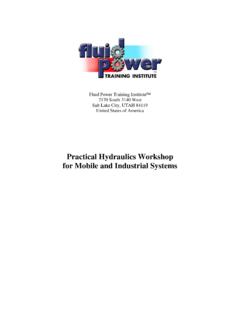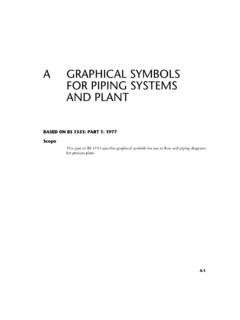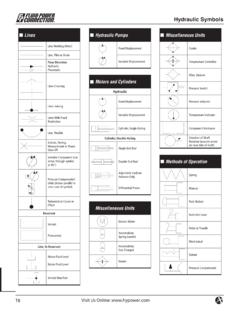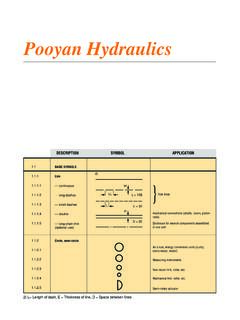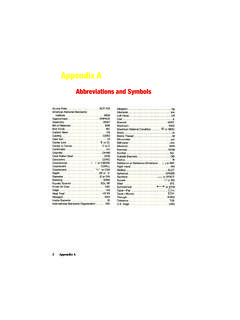Transcription of Binary Logic Diagrams for Process Operations
1 American National (R 1992)Reaffirmed July 13, 1992 Binary Logic Diagramsfor Process OperationsCopyright 1992 by the Instrument Society of America. All rights reserved. Printed in the UnitedStates of America. No part of this publication may be reproduced, stored in a retrieval system, ortransmitted in any form or by any means (electronic, mechanical, photocopying, recording, orotherwise), without the prior written permission of the Alexander Box 12277 Research Triangle Park, North Carolina Binary Logic Diagrams for Process OperationsISBN 0-87664-331-4 (R 1992)3 PrefaceThis preface is included for informational purposes and is not part of Standard Standard has been prepared as a part of the service of ISA toward a goal of uniformity in the field of instrumentation.
2 To be of real value, this document should not be static, but should be subject to periodic review. Toward this end, the Society welcomes all comments and criticisms, and asks that they be addressed to the Secretary, Standards and Practices Board, ISA, 67 Alexander Drive, Box 12277, Research Triangle Park, NC 27709, Telephone (919) 549-8411, e-mail: ISA Standards and Practices Department is aware of the growing need for attention to the metric system of units in general, and the International System of Units (SI) in particular, in the preparation of instrumentation standards. The Department is further aware of the benefits to USA users of ISA Standards of incorporating suitable references to the SI (and the metric system) in their business and professional dealings with other countries.
3 Toward this end this Department will endeavor to introduce SI-acceptable metric units in all new and revised standards to the greatest extent possible. The Metric Practice Guide, which has been published by the American Society for Testing and Materials as ANSI designation (ASTM E380-76, IEEE Std. 286-1975), and further revisions, will be the reference guide for definitions, symbols , abbreviation, and conversion is the Policy of ISA to encourage and welcome the participation of all concerned individuals and interests in the development of ISA Standards. Participation in the ISA Standards making Process by an individual in no way constitutes endorsement by the employer of that individual of ISA or any of the Standards which ISA system described in this Standard is intended to meet the needs of people who are concerned with the operation of Process systems.
4 The guide for the Standard was American National Standards Institute (ANSI) Standard , graphic symbols for Logic Diagrams , which the committee attempted to follow so far as practical for the intended users of the ISA Committee also referred to National Electric Manufacturers Association Standards ICS 1-102, graphic symbols for Logic Diagrams , whose symbols bear resemblance to those of the ANSI Standard, and ICS 1-103, Static Switching Control Devices, which may eventually be supplanted by ICS 1-102. Reference was also made to National fluid power Association Recommended Standard , graphic symbols for Fluidic Devices and Circuits. In addition, numerous other industrial standards were following people served on the 1976 Committee:NAMECOMPANYG eorge Platt, ChairmanBechtel power CompanyEdward J.
5 BlahutProcon Incorporated, Pacific OperationsSanford ChalfinFluor CorporationLouis CosteaHunt-Wesson Foods, IncorporatedRussell C. GreerBailey Meter CompanyRoy LazarCarnation Company4 (R 1992)Frank Mehle (deceased)Procon Incorporated, Pacific OperationGary L. PierceShell Oil CompanyChuck SimmsFisher Controls CompanyJohn VanceUnited Process Control SystemsRobert WooLos Angeles Department of Water & PowerThe following people served on the 1981 (reaffirmation) Committee:NAMECOMPANYR ussell C. Greer, ChairmanBailey Controls CompanyEdward J. BlahutBlahut Engineering, ChalfinFluor Corporation (retired)Louis CosteaHunt-Wesson Foods, LazarCarnation CompanyGary L. PierceShell Oil CompanyGeorge PlattBechtel power CorporationCharles SimmsFisher Controls CompanyJohn VanceComsyscoRobert WooLos Angeles Department of Water & PowerThe 1976 edition of this Standard was approved by the ISA Standards and Practices Board in November, B.
6 Miller, ChairmanMoore Products CompanyP. BlissPratt & Whitney Aircraft CompanyE. J. ByrneBrown & Root, CalderThe Foxboro CompanyB. A. ChristensenContinental Oil CompanyL. N. CombsE. I. du Pont de Nemours & Company (retired)R. L. GalleyBechtel power CorporationR. G. Hand, SecretaryISAT. J. HarrisonIBM CorporationT. S. ImslandFisher Controls CompanyP. S. LedererNational Bureau of StandardsO. P. Lovett, I. du Pont de Nemours & CompanyE. C. MagisonHoneywell, L. MartinTex-A-Mation Engineering P. McCauleyGlidden-Durkee Div. SCM CorporationT. A. MurphyThe Fluor Corporation, L. NickensReynolds Metals CompanyG. PlattBechtel power CorporationA. T. UpfoldPolysar A. WhitmanAllied Chemical (R 1992)5 This standard was reaffirmed by the ISA Standards and Practices Board in March, J.
7 Harrison, ChairmanIBM CorporationP. BlissConsultantW. CalderThe Foxboro CompanyB. A. ChristensenContinental Oil CompanyM. R. Gorden-ClarkScott Paper CompanyR. T. JonesPhiladelphia Electric CompanyR. KellerBoeing CompanyO. P. Lovett, ValveE. C. MagisonHoneywell, P. McCauleyDiamond Shamrock CorporationE. M. NesvigERDCO Engineering CorporationR. L. NickensReynolds Metals CompanyG. PlattBechtel power CorporationR. PrescottMoore Products CompanyR. W. SignorGeneral Electric CompanyW. C. WeidmanGilbert Associates, A. WhitmanAllied Chemical CorporationL. N. Combs* R. L. Galley*R. G. Marvin*W. B. Miller*Moore Products CompanyJ. R. Williams*Stearns-Rogers, Inc.*Director (R 1992)7 Contents1 Purpose ..92 Scope .. 93 Use of symbols .. 94 symbols .. 115 Bibliography .. 18 Appendix A General application example.
8 19 Appendix B Complex time-element example .. 26 Appendix C Loss of power supply for memory .. 27 (R 1992)91 The purpose of this Standard is to provide a method of Logic diagramming of Binary interlock and sequencing systems for the startup, operation, alarm, and shutdown of equipment and pro-cesses in the chemical, petroleum, power generation, air conditioning, metal refining, and numer-ous other The Standard is intended to facilitate the understanding of the operation of Binary systems, and to improve communications among technical, management, design, operating, and mainte-nance personnel concerned with the The Standard provides symbols , both basic and non-basic, for Binary operating functions. The use of symbols in typical systems is illustrated in The Standard is intended to symbolize the Binary operating functions of a system in a manner that can be applied to any class of hardware, whether it be electronic, electrical, fluidic, pneumatic, hydraulic, mechanical, manual, optical, or Use of By using the symbols designated as "basic," Logic systems may be described with the use of only the most fundamental Logic building blocks.
9 The remaining symbols , not basic, are more comprehensive and enable Logic systems to be diagrammed more concisely. Use of the non-basic symbols is A Logic diagram may be more or less detailed depending on its intended use. The amount of detail in a Logic diagram depends on the degree of refinement of the Logic and on whether auxiliary, essentially non- Logic , information is an example of refinement of detail: A Logic system may have two opposing inputs, , a command to open and a command to close, which do not normally exist simultaneously; the Logic diagram may or may not go so far as to specify the outcome if both the commands were to exist at the same time. In addition, explanatory notes may be added to the diagram to record the Logic information may also be added, if desired, , reference document identification, tag numbers, terminal markings, these ways, the diagram may provide the level of detail appropriate, for example, for communication between a designer of pneumatic circuits and a designer of electric circuits, or may provide a broad-view system-description for a plant (R 1992) The existence of a Logic signal may correspond physically to either the existence or the non-existence of an instrument signal, depending on the particular type of hardware system and the circuit design philosophy that are selected.
10 * For example, a high-flow alarm may be chosen to be actuated by an electric switch whose contacts open on high flow; on the other hand, the high-flow alarm may be designed to be actuated by an electric switch whose contacts close on high flow. Thus, the high-flow condition may be represented physically by the absence of an electric signal or by the presence of the electric signal. The Standard does not attempt to relate the Logic signal to an instrument signal of any specific A Logic symbol that is shown in Section 4 with three inputs A, B, and C is typical for the Logic function having any number of two or more The flow of intelligence is represented by lines that interconnect Logic statements. The normal direction of flow is from left to right, or top to bottom. Arrowheads may be added to the flow lines wherever needed for clarity, and shall be added to lines whose flow is not in a normal A summary of the status of an operating system may be put in the diagram wherever it is deemed useful as a reference point or landmark in the There may be misunderstanding of Binary Logic statements involving devices that are not recognizable as inherently having only two specific alternative states.




